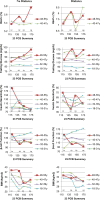Persistent organic pollutants in young adults and changes in glucose related metabolism over a 23-year follow-up
- PMID: 25706918
- PMCID: PMC4429782
- DOI: 10.1016/j.envres.2014.11.001
Persistent organic pollutants in young adults and changes in glucose related metabolism over a 23-year follow-up
Abstract
Objectives: Substantial evidence associates persistent organic pollutants (POP) with metabolic disturbances related to diabetes, but longitudinal studies with repeated measures are scarce. We aimed to characterize the association between background exposures to POPs with repeated measures of glucose homeostasis over 23-years.
Methods: Within the Coronary Artery Risk Development in Young Adults study (year 0 ages: 18-30 years), we measured POPs in serum obtained in 1987-88 (follow-up year 2) in 90 non-diabetic controls and 90 cases diabetes-free at year 2 who became diabetic by year 20. We analyzed 32 POPs detectable in ≥75% of participants and created summary scores for 32 POPs, 23 polychlorinated biphenyls (PCB), and 8 organochlorine pesticides (OCP). Dependent variables were measures of glucose homeostasis at years 0-25 (up to 8 examinations). We explored associations using repeated measures regression adjusted for race, sex, concurrent body mass index (BMI), examination center and period, separately for cases and controls.
Results: The associations between the three summary scores and measures of glucose homeostasis were present for observations at ages 40-55 years, and particularly between 48-55 years: the 23 PCB summary was associated with HbA1c (never-diabetics: slope [value per unit of summary score], β=0.008, p=0.02; diabetics: β=0.03, p=0.07), fasting glucose (never-diabetics: β=0.24, p=0.003; diabetics: β=1.10, p=0.03), and insulin sensitivity% (never-diabetics: β=-2.82, p<0.001, diabetics: β=-0.31, p=0.30). No associations were observed at younger ages.
Conclusions: Glucose homeostasis may worsen after decades of exposure to PCBs and OCPs at background environmental levels, independent of BMI and after participants reached the 5th decade of life.
Keywords: Glucose; HbA1c; Organochlorine; PCB; POPs.
Copyright © 2014 Elsevier Inc. All rights reserved.
Conflict of interest statement
None.
Figures

References
-
- Airaksinen R, Rantakokko P, Eriksson JG, Blomstedt P, Kajantie E, Kiviranta H. Association between type 2 diabetes and exposure to persistent organic pollutants. Diabetes Care. 2011;34:1972–1979. http://dx.doi.org/10.2337/dc10-2303. - DOI - PMC - PubMed
-
- Barr JR, Maggio VL, Barr DB, Turner WE, Sjödin A, Sandau CD, et al. New high-resolution mass spectrometric approach for the measurement of polychlorinated biphenyls and organochlorine pesticides in human serum. J Chromatogr B: Analyt Technol Biomed Life Sci. 2003;794:137–148. - PubMed
-
- Bertazzi PA, Consonni D, Bachetti S, Rubagotti M, Baccarelli A, Zocchetti C, et al. Health effects of dioxin exposure: a 20-year mortality study. Am J Epidemiol. 2001;153:1031–1044. - PubMed
-
- Camhi SM, Bray GA, Bouchard C, Greenway FL, Johnson WD, Newton RL, et al. The relationship of waist circumference and BMI to visceral, subcutaneous, and total body fat: sex and race differences. Obesity (Silver Spring) 2011;19:402–408. http://dx.doi.org/10.1038/oby.2010.248. - DOI - PMC - PubMed
-
- Centers for Disease Control and Prevention. Environ Heal NCEH Pub. Atlanta, GA: 2009. Fourth National Report on Human Exposure to Environmental Chemicals; p. 529.
Publication types
MeSH terms
Substances
Grants and funding
- HHSN268201300026C/HL/NHLBI NIH HHS/United States
- R01HL53560/HL/NHLBI NIH HHS/United States
- R01 HL053560/HL/NHLBI NIH HHS/United States
- AG0005/AG/NIA NIH HHS/United States
- HHSN268201300025C/HL/NHLBI NIH HHS/United States
- ImNIH/Intramural NIH HHS/United States
- HHSN268201300029C/HL/NHLBI NIH HHS/United States
- T32HL007779/HL/NHLBI NIH HHS/United States
- HHSN268201300027C/HL/NHLBI NIH HHS/United States
- T32 HL007779/HL/NHLBI NIH HHS/United States
- HHSN268200900041C/HL/NHLBI NIH HHS/United States
- HHSN268201300028C/HL/NHLBI NIH HHS/United States
LinkOut - more resources
Full Text Sources
Other Literature Sources
Medical

